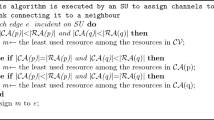Abstract
Cognitive smartphone network (CSN), the smartphone network with cognitive radio features, has been advocated as an effective approach to improve the transmission bandwidth. Compared with the traditional smartphone network, cooperative spectrum sensing (CSS) is a special technique of smartphone sensing, however, is still an open issue. In this paper, we consider a practical power-limited cluster-based CSN, in which one end user can only share the sensing messages broadcasted by its neighbors. Aiming at improving the performance of CSS, we propose a relay-assisted random broadcast scheme to extend the range of message sharing. We introduce the message sharing probability (MSP) to quantify the performance of message sharing, and the restricted random broadcast model to simplify the theoretical analysis of MSP. We then employ the proposed scheme for CSS in a CSN, and study the problem of sensing–sharing tradeoff. Simulations show that our proposed scheme can achieve substantial performance improvement on both message sharing and CSS compared to the scheme without relays. Moreover, it is indicated that the performance of CSS can be maximized by optimizing the duration of message sharing when a total sensing time is given.






Similar content being viewed by others
Notes
It must be pointed out that \( P\left( {S_{d} } \right) \) can be improved by adjusting \( \lambda_{d} \) in time (see the details in [12]). However, to simplify the performance analysis of the proposed relay-assisted random broadcast, a fixed probability of \( \lambda_{d} \) is used in this paper.
References
Rashvand, H.F., Hsiao, K.-F.: Smartphone intelligent applications: a brief review. Multimed. Syst. 1–17 (2013). doi:10.1007/s00530-013-0335-z
Silva, J.M., El Saddik, A.: Exertion interfaces for computer videogames using smartphones as input controllers. Multimed. Syst. 19(3), 289–302 (2013). doi:10.1007/s00530-012-0268-y
Mitola Iii, J.: Cognitive radio for flexible mobile multimedia communications. In: IEEE International Workshop on Mobile Multimedia Communications, pp. 3–10 (1999)
Chen, C.-C., Huang, T.-C., Park, J.J., Yen, N.Y.: Real-time smartphone sensing and recommendations towards context-awareness shopping. Multimed. Syst. 1–12 (2013). doi:10.1007/s00530-013-0348-7
Liu, Y., Cai, L.X., Shen, X., Luo, H.: Deploying cognitive cellular networks under dynamic resource management. Wirel. Commun. IEEE 20(2), 82–88 (2013)
Ma, J., Li, G.Y., Juang, B.H.: Signal processing in cognitive radio. Proc. IEEE 97(5), 805–823 (2009)
Haykin, S., Thomson, D.J., Reed, J.H.: Spectrum sensing for cognitive radio. Proc. IEEE 97(5), 849–877 (2009)
Liang, Y.C., Zeng, Y., Peh, E.C., Hoang, A.T.: Sensing-throughput tradeoff for cognitive radio networks. IEEE Trans. Wirel. Commun. 7(4), 1326–1337 (2008)
Ganesan, G., Li, Y.: Cooperative spectrum sensing in cognitive radio, part I: two user networks. IEEE Trans. Wirel. Commun. 6(6), 2204–2213 (2007)
Liang, Y., Lai, L., Halloran, J.: Distributed cognitive radio network management via algorithms in probabilistic graphical models. IEEE J. Sel. Areas Commun. 29(2), 338–348 (2011)
Li, H., Dai, H., Li, C.: Collaborative quickest spectrum sensing via random broadcast in cognitive radio systems. IEEE Trans. Wirel. Commun. 9(7), 2338–2348 (2011)
Chen, R.R., Teo, K.H., Farhang-Boroujeny, B.: Random access protocols for collaborative spectrum sensing in multi-band cognitive radio networks. IEEE J. Sel. Top. Signal Process. 5(1), 124–136 (2011)
Peh, E., Liang, Y.C.: Optimization for cooperative sensing in cognitive radio networks. In: IEEE Wireless Communications and Networking Conference, pp. 27–32 (2007)
Zhang, Q., Jia, J., Zhang, J.: Cooperative relay to improve diversity in cognitive radio networks. IEEE Commun. Mag. 47(2), 111–117 (2009)
Luo, C., Yu, F.R., Ji, H., Leung, V.C.: Distributed relay selection and power control in cognitive radio networks with cooperative transmission. In: IEEE International Conference on Communications, pp. 1–5 (2010)
Zhao, G., Ma, J., Li, G.Y., Wu, T., Kwon, Y., Soong, A., Yang, C.: Spatial spectrum holes for cognitive radio with relay-assisted directional transmission. IEEE Trans. Wirel. Commun. 8(10), 5270–5279 (2010)
Wang, R., Lau, V.K., Cui, Y.: Decentralized fair scheduling in two-hop relay-assisted cognitive OFDMA systems. IEEE J. Sel. Top. Signal Process. 5(1), 171–181 (2011)
Author information
Authors and Affiliations
Corresponding author
Rights and permissions
About this article
Cite this article
Zhao, Q., Wu, Z., Zhang, D. et al. Cooperative spectrum sensing via relay-assisted random broadcast in cognitive smartphone networks. Multimedia Systems 21, 5–13 (2015). https://doi.org/10.1007/s00530-014-0385-x
Published:
Issue Date:
DOI: https://doi.org/10.1007/s00530-014-0385-x




